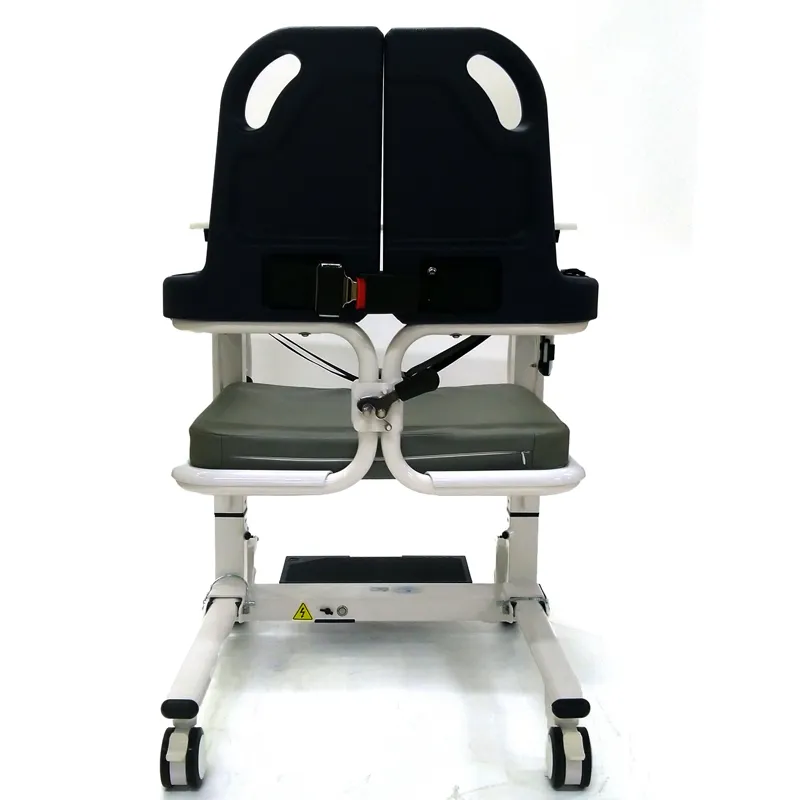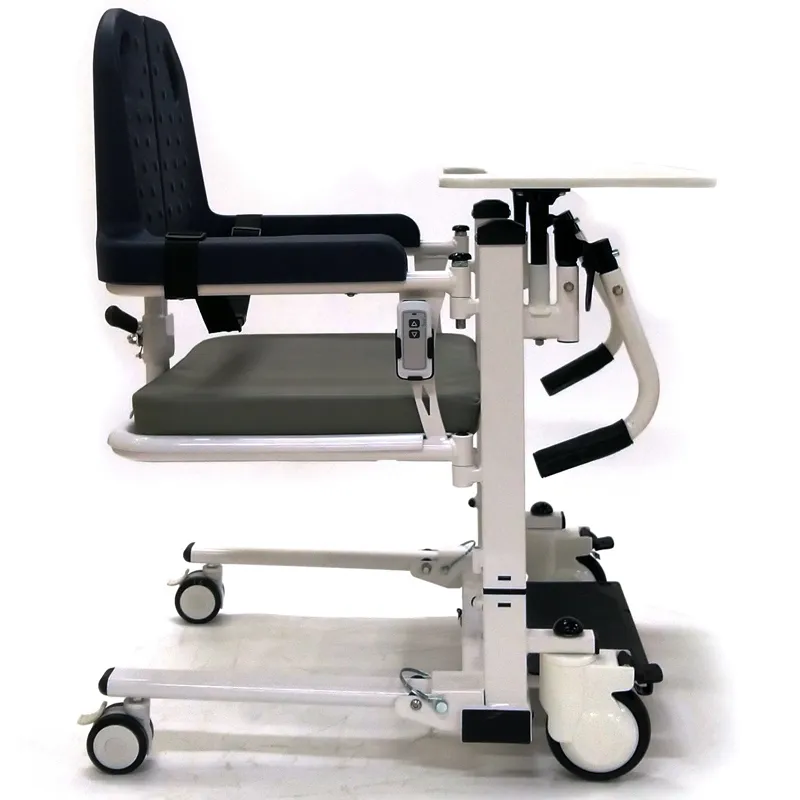In medical and home care, the Patient Lift Transfer Chair is a common assistive device. It helps caregivers easily and safely transfer patients from beds, chairs, or wheelchairs. However, many people mistakenly believe that the Patient Lift Transfer Chair functions similarly to a wheelchair, and even try to use it directly as such.
However, from multiple perspectives, including design structure, safety standards, and intended use, the Patient Lift Transfer Chair cannot replace a wheelchair. This incorrect use not only affects patient safety but may also lead to equipment damage or create care risks.
This article will systematically explain why the Patient Lift Transfer Chair cannot be used as a wheelchair and analyze in detail the differences between the two, applicable scenarios, and potential risks.

Patient Lift Transfer Chair: What Do You Know?
1. Basic Functions of the Patient Lift Transfer Chair
The Patient Lift Transfer Chair is an assistive device specifically designed to help caregivers safely transfer patients with limited mobility. It typically features the following functions:
• Height adjustment: The chair height can be adjusted manually via hydraulic or electric systems, allowing for safe transfer of the patient from bed, sofa, or toilet;
• Transfer function: Equipped with a sliding or folding structure, it can move the patient short distances (e.g., from the ward to the bathroom);
• Nursing assistance function: Facilitates patient bathing, dressing, toileting, and other nursing activities.
Therefore, the core objective of the Patient Lift Transfer Chair is transfer and assisted care, rather than long-distance movement or outdoor travel.
2. Typical Structure of a Patient Lift Transfer Chair
A common Patient Lift Transfer Chair consists of the following components:
• A robust metal frame (mostly powder-coated steel);
• A lifting support mechanism (hydraulic rods or electric lifting devices);
• An openable seat (for easy transfer);
• Lockable casters (for easy short-distance movement but not suitable for prolonged gliding);
• Safety belts or guardrails (to ensure safety during transfer).
These design features determine its functional attributes: suitable for static care and short-distance transfers, rather than continuous movement or daily travel.

Why can't a Patient Lift Transfer Chair be used as a wheelchair?
Many people, seeing the wheels on a Patient Lift Transfer Chair, naturally assume it can be pushed around and mistakenly believe it can replace a wheelchair. However, their purposes are completely different.
Below are several reasons why they cannot be used interchangeably.
1. Completely Different Design Purposes
• Wheelchairs are designed to enable people with mobility limitations to achieve daily travel and autonomy;
• Patient Lift Transfer Chairs are designed to allow caregivers to easily transfer patients over short distances and adjust their position.
In other words, wheelchairs serve the "patient themselves," while Patient Lift Transfer Chairs serve the "care process."
Therefore, Patient Lift Transfer Chairs are not designed for long-term weight-bearing and continuous movement.
2. Insufficient Structural Stability to Support Prolonged Use
Wheelchairs have a shock-absorbing and reinforced chassis structure with a specialized bearing system, capable of handling various surfaces (such as roads, ramps, and turns). The casters of the Patient Lift Transfer Chair are only designed for short-distance movement on smooth indoor surfaces and are not suitable for road use.
Prolonged use or pushing on uneven surfaces can easily lead to:
• Deformed casters;
• Loose bearings;
• Frame instability;
• Tilting over, causing patient injury.
3. Significant differences in comfort and ergonomic design
Wheelchairs typically feature seat cushions, backrests, and armrests designed to conform to the human body's curves, ensuring patient comfort and blood circulation during extended periods of sitting.
The Patient Lift Transfer Chair prioritizes ease of care, with seats often being removable or open for easy access to the toilet or bathing.
Sitting in the Patient Lift Transfer Chair for extended periods may cause:
• Discomfort in the buttocks due to the high firmness and concentrated pressure of the seat;
• Instability in posture and lack of lumbar support;
• Poor blood circulation, and even the risk of pressure sores.
Therefore, from a health perspective, the Patient Lift Transfer Chair should not be used as a wheelchair.
4. Different Safety Systems
Wheelchairs are equipped with dedicated braking systems, anti-tipping devices, footrests, and anti-slip wristbands, adaptable to various usage scenarios, whether self-propelled or pushed.
The brakes on a Patient Lift Transfer Chair are only designed for fixed positions and lack safety protection during continuous movement.
Using it for mobility or downhill travel poses an extremely high risk.
5. Different Load Capacities and Usage Frequency
A standard Patient Lift Transfer Chair has a maximum load capacity of approximately 100–150 kg, with a structure geared towards vertical lifting and static support;
High-strength wheelchairs, on the other hand, have a much greater load capacity (typically exceeding 200 kg) and can withstand frequent pushing and road vibrations.

Patient Lift Transfer Chair and Wheelchair: What are the Main Differences?
To illustrate this more clearly, a comparison table shows the core differences between the two:
Project | Patient Lift Transfer Chair | Wheelchair |
| Main Purpose | For patient getting in and out of bed, patient transfer, bathing, and toileting | Patient's daily mobility and travel |
| Design Focus | Convenient and safe lifting for nursing staff | Comfort and maneuverability |
| Main User | Easy for nursing staff to operate | Pushed by the user or caregiver |
| Travel Distance | Short distance indoors | Suitable for long-distance and outdoor use |
| Structural Features | Lifting support, opening and closing seat, lockable casters | Large-wheel drive system, shock-resistant structure |
| Safety Features | Fixed brakes, guardrails, safety belts | Independent braking, anti-tipping, foot support |
| Comfort Level | Generally functional | Highly comfortable, ergonomic |
| Long-Term Use Capability | No | Yes |
| Roadworthiness | No | Yes (in some situations) |
The comparison clearly shows that the core function of the Patient Lift Transfer Chair is limited to "assisted transfer," not "mobility."
What risks are associated with using a Patient Lift Transfer Chair as a wheelchair?
This incorrect use is not uncommon in nursing care, but the potential risks are very high.
1. Risk of Equipment Damage
Frequent pushing or prolonged use can overload the casters, lifting mechanism, and support structure, leading to:
• Oil leaks or malfunctions in the lifting rod;
• Deformation or weld cracking of the bracket;
• Uneven base, affecting safety and stability.
2. Risk of User Injury
Because the Patient Lift Transfer Chair lacks the protective structure of a wheelchair, patients are prone to tilting or falling when turning, going downhill, or on uneven ground.
3. Increased Burden on Caregivers
The transfer chair's pushing mechanism is relatively simple and lacks an optimal ergonomic design for the pushing handle. Prolonged pushing increases the physical burden on caregivers and may even lead to accidents.
4. Loss of Equipment Warranty and Safety Guarantee
Most manufacturers explicitly state that if the Patient Lift Transfer Chair is used for purposes other than its intended use (such as as a wheelchair), it will automatically lose its warranty. This means that repair costs after equipment damage must be borne by the caregiver.
Patient Lift Transfer Chair: Correct Usage Scenarios
While a Patient Lift Transfer Chair cannot be used as a wheelchair, it is indispensable in certain care scenarios.
1. Bed-to-Chair Transfers
Assisting patients from their beds to sofas, commodes, or wheelchairs is the most common use of a Patient Lift Transfer Chair.
2. Bathing and Toileting Assistance
Some models feature a waterproof construction and an open seat, allowing direct use in the bathroom and reducing the need for secondary handling.
3. Short-Distance Care Mobility
Short-distance movements, such as from the ward to the bathroom or from the bedroom to the living room. The casters allow for gentle pushing, but continuous gliding is not recommended.
4. Safety Support During Care
Providing stable support during changing clothes, cleaning the body, or repositioning. These usage scenarios fully demonstrate the unique value of the Patient Lift Transfer Chair in the field of care, but also clearly define its usage boundaries.

What Equipment Should Be Chosen If the Patient Needs Mobility?
Since a Patient Lift Transfer Chair cannot be used as a wheelchair, what equipment should be chosen for patients who need mobility?
1. Electric Wheelchair
Suitable for patients with limited mobility who wish to move independently. Daily mobility is achieved through an electric control system.
2. Manual Wheelchair
Suitable for patients with relatively good upper limb strength who need short-distance mobility. Lightweight and inexpensive.
3. Nursing Wheelchair
Designed specifically for long-term care environments, typically equipped with an adjustable backrest, bedpan, and footrests, combining mobility and nursing functions.
These devices all possess structures and safety features suitable for mobility, complementing the Patient Lift Transfer Chair.
What should caregivers pay attention to when using the Patient Lift Transfer Chair?
Proper operation not only extends the lifespan of the device but also ensures patient safety.
Key precautions are as follows:
• Check the lifting mechanism for smooth operation before use;
• Ensure the casters are locked to prevent slippage during transfer;
• Fasten the patient's safety belt or restraint strap after positioning;
• Perform lifting and lowering smoothly to avoid swaying;
• Do not push the device onto ramps or stairs;
• Wipe dry and keep the device dry after use to prevent metal parts from rusting.
The Patient Lift Transfer Chair is not a wheelchair
The Patient Lift Transfer Chair should not be used as a wheelchair!
Reasons include:
• Different design purposes;
• Significant differences in structure and safety standards;
• The Patient Lift Transfer Chair is not designed for long-term mobility or road use;
• Prolonged or improper use increases risks and wear and tear.
Therefore, the Patient Lift Transfer Chair should only be used for nursing care and short-distance transfers. For mobility, travel, and outdoor activities, choose a suitable wheelchair.
How can I get a quote from Dayang Medical?
Getting a factory quote from Dayang Medical is simple. Buyers just need to contact our sales team with product details such as model, quantity, and customization requirements. We respond quickly with accurate prices for items like electric wheelchairs, hospital beds, walkers, and shower chairs.
Many international brands purchase directly from our factory because our quotes are transparent, competitive, and supported by high quality production and reliable supply.


